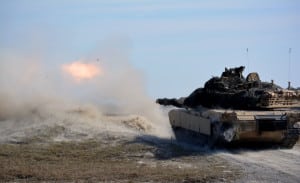The State Department has approved a potential $2.53 billion deal with Romania, which includes the sale of 54 M1A2 SEPv3 Abrams tanks.
The Defense Security Cooperation Agency (DSCA) notified Congress on Thursday of the new foreign military sale.

The U.S.’ approval of the sale follows the Romanian government’s decision in May to move forward on the deal to purchase the used General Dynamics Land Systems [GD]-built M1A2 tanks.
“The proposed sale will improve Romania’s capability to meet current and future threats by providing a credible force that is capable of deterring adversaries and participating in NATO operations,” the DSCA said in a statement on Thursday.
Along with Abrams tanks, Romania would receive four of BAE Systems’ M88A2 combat recovery vehicles, four Leonardo DRS’ Joint Assault Bridges, four M1150 Assault Breacher Vehicles and four Heavy Assault Scissor Bridges, mine rollers and Oshkosh Defense [OSK]-built EHET M1300 tractors, HEMTT M978A4 fuel servicing trucks and HEMTT A4 Load Handling Systems.
The deal also includes 54 M240C 7.62mm machine guns, 10 AGT1500 gas turbine engines, nearly 6,000 120mm M1147 tank rounds and over 4,000 120mm target practice rounds, Common Remotely Operated Weapons Stations, .50 caliber machine guns, communications equipment, GPS receivers and spare and repair parts.
GD Land Systems in December 2020 received a $4.6 billion deal from the U.S. Army for the modernized SEPv3 upgrades for Abrams, with work expected to be completed by June 2028 (Defense Daily, Dec. 18 2020).
The U.S. Army in September detailed plans to pivot away from its M1A2 SEPv4 upgrade effort for its tanks and will focus instead on developing a new M1E3 Abrams it aims to field by the early 2030s with capability improvements required for future fights (Defense Daily, Sept. 7).
The Army said development of the M1E3 Abrams will leverage the “best features” from M1A2 SEPv4 work, while also focusing on building around modular open systems architecture standards to allow for “quicker technology upgrades and requiring fewer resources.”